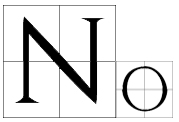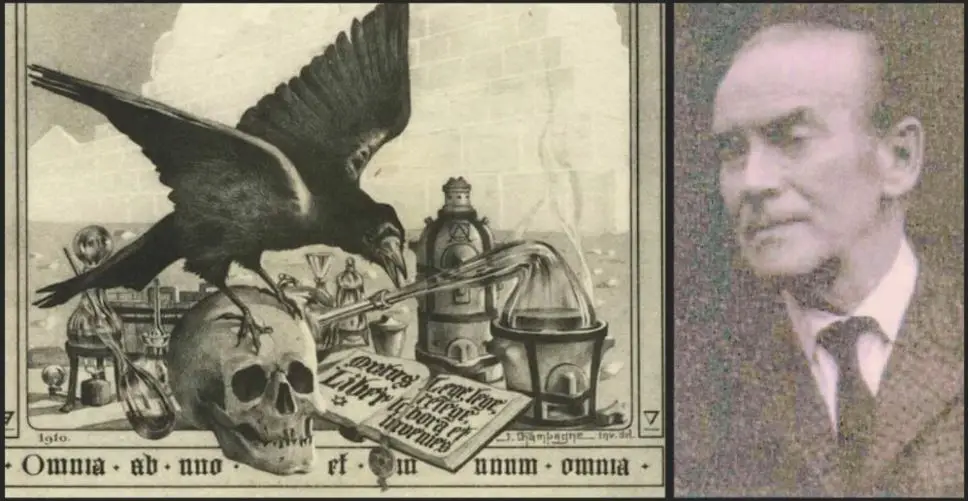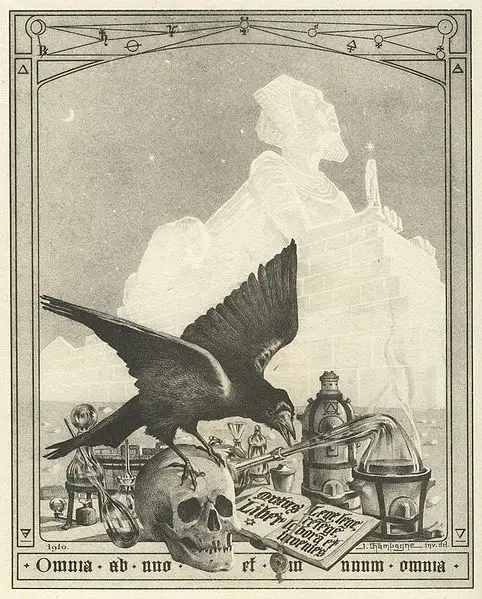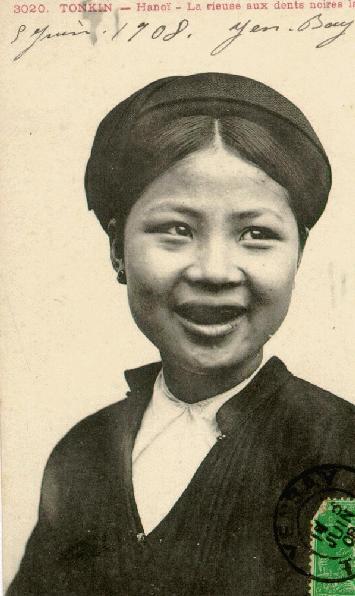 one knows who Fulcanelli was, the pseudonym behind a great work and an even greater legend. Many dedicated seekers have tried to identify his traces, but apart from discovering their own paths, they have had no luck. Even when explaining the alchemical process of transforming metal into gold and overcoming death, Fulcanelli confused the interlocutor by leading him back from the alchemical process to his identity: “…the vital thing is not the transmutation of the metals, but that of the experimenter himself. It is an ancient secret that is rediscovered by a few people every century. Unfortunately, only a handful of them succeed...”
one knows who Fulcanelli was, the pseudonym behind a great work and an even greater legend. Many dedicated seekers have tried to identify his traces, but apart from discovering their own paths, they have had no luck. Even when explaining the alchemical process of transforming metal into gold and overcoming death, Fulcanelli confused the interlocutor by leading him back from the alchemical process to his identity: “…the vital thing is not the transmutation of the metals, but that of the experimenter himself. It is an ancient secret that is rediscovered by a few people every century. Unfortunately, only a handful of them succeed...”
Fulcanelli bestowed the 20th century, marked by increasing scientific discoveries, with many references to the secret ancient knowledge for mastering the forces of the material world in his two hermetic books, The Mysteries of Cathedrals (Paris 1926 / USA 1971) and The Dwellings of a Philosopher (Paris 1929), published by his students after his mysterious disappearance in 1926. The work that bears his name attracted a whole new group of seekers who suddenly believed in the power of their own magic and understood that ancient knowledge is actually preserved by the unknown individuals who have managed to master their lives despite all material laws.
But although Fulcanelli made his appearances in the first half of the 20th century, it wasn’t until 1963, with the publication of The Morning of the Magicians, that English-speaking occultists and students of alchemy became aware of Fulcanelli, and for the first time in history, the European tradition of alchemy fully merged with the American tradition that had flourished for decades.

Alchemy is the mastery of overcoming limitations by following a unique, individual path that tests the craft of transformation in each and every life situation. And knowing that they come with limitations and that the American mind was free from the heavy European shackles of principles, Fulcanelli’s American meeting was the final milestone for alchemy, which could develop more quickly now that it was widely available.
Today, one can easily access many sources and tools to get started. If only one could learn the language because the comprehensive level hasn’t changed. It’s still alchemy, the mysterious process of fusion into something new and limitless.
The Morning of the Magicians
Jacques Bergier was a chemical engineer, member of the French Resistance, and writer who, together with Louis Pauwels, wrote the famous cult classic The Morning of the Magicians, in which they link alchemy to atomic physics and suggest that the early alchemists knew more about the actual function of atoms than was officially assumed and known. They also argued at length about the connection of National Socialism with the occult, which opened up a new level of understanding of Hitler’s work against humanity.
The idea that the spiritual world, as portrayed in occultism, can have just as dark an effect as the material world has always been part of the collective database, but was only really recognized when science made some revolutionary discoveries, followed by civilizational mistakes. And when science showed its dangerous face people began to treat it like the occult, as something bigger and more powerful than man and capable of doing harm.
Hence, science was elevated to uncontrollable nature and as a result, new religious and spiritual systems exploded in the West. But as the West demonstrated its military power over the East and capitalism unleashed its dynamism while restricting people with new laws, alchemy was once again a rare knowledge that stood on the dusty shelves of a few small libraries that don’t stand out in modern urban architecture.
Nevertheless, alchemy is always close to humanity, as it is fundamentally a humanistic science that aims to improve the world by mastering one’s own world. And so it is not surprising that Bergier, who was so well-read, educated, and experienced, had many stories about Fulcanelli and included them in his book. One of them is the famous warning about the use of nuclear weapons, but the dates are so shifted that it is hard to confirm any of the claims.
Fulcanelli’s Warning
The meeting between Bergier and Fulcanelli allegedly took place in June 1937, when Bergier was working in a laboratory of the Gas Board in Paris as an assistant to the noted French nuclear physicist André Helbronner, who was murdered by the Gestapo towards the end of the World War II.
Bergier claimed that eight years before the first atomic bomb test in New Mexico, he was approached by a formidable, mysterious stranger and asked to deliver a message to Andre Helbronner. The man said that he felt it was his duty to warn orthodox scientists of the danger of nuclear energy since the alchemists of the past had obtained this secret knowledge and it had destroyed them. The mysterious stranger added that he had no hope that his warning would be heeded, but he felt that he had to issue it any way. Jacques Bergier was convinced until his death that the stranger was Fulcanelli. This is the quote:
“You are on the verge of success, as are some of our other scientists today. Please, allow me. Be very, very careful. I warn you… The release of nuclear power is easier than you think, and the artificially produced radioactivity can poison the atmosphere of our planet in a very short time: in a few years. Moreover, a few grains of metal can be used to make nuclear explosives powerful enough to destroy entire cities. I tell you this with certainty: the alchemists have known it for a long time… I will not try to prove to you what I am about to say, but I ask you to repeat it to Mr. Helbronner: Certain geometrical arrangements of highly purified materials are sufficient to release atomic forces without having to resort to electricity or vacuum techniques… The secret of alchemy is this: There is a way to manipulate matter and energy to create what modern scientists call a “force field”. This field acts on the observer and puts him in a privileged position in relation to the universe. From this position, he has access to realities normally hidden from us by time and space, matter and energy. This is what we call the Great Work.”
The story was so unbelievable that it caught the attention of the American Office for Strategic Services, the precursor of the CIA, which launched an intensive search for Fulcanelli after the war ended. He was never found. This is contradicted by the fact that plutonium was specifically named by the mystery man, although it was not isolated until February 1941 and not named until March 1942, five years after Bergier’s encounter.
Nevertheless, Bergier stuck to his story and knowing that alchemists throughout history have been credited with the ability to time travel, knowing the name of the plutonium poses no problem.
The alchemists’ enclave in the Pyrenees
The last time Fulcanelli was seen was in 1954, when his student Eugène Canseliet, who first published and wrote the preface to the both French and English editions of Mystery of the Cathedrals, traveled to Seville, where he was picked up and led on long diversions to large mountain castle that turned out to be an enclave of alchemists.
He said that Fulcanelli seemed to have undergone a strange form of transformation so that he had both male and female characteristics – he was androgynous, which is the final stage of alchemical transformation. The adept who undergoes this transformation loses all hair, teeth, and nails and grows new ones. The skin becomes younger and smoother and the face takes on asexual features. Canseliet said that at one point Fulcanelli had the complete facial features of a woman.
But after his visit to the alchemists’ enclave, apparently, somewhere in the Pyrenees, Canseliet said he had only vague memories of his experiences with the master. However, his passport contained a Spanish entry stamp for 1954.
So if we are to believe all these stories, we must assume that there is a colony of alchemists in Spain who are as good at watching us as we are at listening to them.

Writer and director who thinks different and does everything differently. Art enthusiast. Wandering and wondering. Until the end of meaning.
irena_curik@hotmail.com





